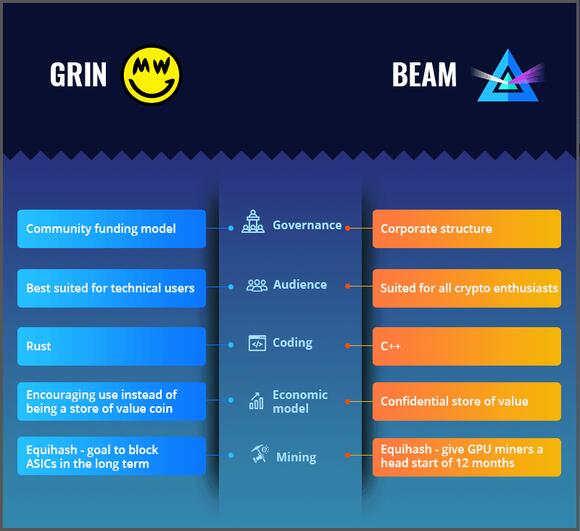MimbleWimble is probably best known to Harry Potter fans. Perhaps not quite in the context that we will touch on today, but that should not spoil the fun. In any case, MimbleWimble owes its name to the spell of the same name from Harry Potter. The unlucky person on whom this curse is pronounced finds that his tongue is tied, which prevents him from talking about a certain subject.
After reading this article you will understand what MimbleWimble is, how it can be used and you will understand that the name of MimbleWimble was not chosen by chance.
View quickly
- What is MimbleWimble?
- Proof of Work (PoW)
- The History of MimbleWimble
- How does MimbleWimble work?
- MimbleWimble in practice
- MimbleWimble and Bitcoin
- The Pros and Cons MimbleWimble
- The advantages
- The cons
- Perspective
- Conclusion
Before we start, it is good to watch the short video below, which explains the concept of blockchain.
What is MimbleWimble
MimbleWimble is – in short – a new blockchain technology that uses a different method to structure and store transactions. Privacy is the main driver here. In addition, MimbleWimble (MW) helps with the scalability of blockchain networks, one of the biggest challenges that blockchains have faced for years. In other words, MimbleWimble is another implementation of a Proof of Work (PoW) blockchain that provides greater privacy and network scalability.
What is Proof of Work?
The concept of Proof of Work was created in 1993 as a means of preventing denial of service attacks and other unwanted network services such as spam by requiring the user to ‘work’ for the service. Usually this comes down to using the computing power of the computer.
Bitcoin pioneered Proof of Work in 2009 by using it as a consensus algorithm that validates transactions and sends new blocks to the blockchain. Since then, it has become one of the most widely used cryptocurrency consensus algorithms.
It is impossible to add a new block to the main chain without first finding a valid nonce (= a number that miners use to find the correct hash), which then generates the solution for a specific block (the so-called block hash). Each validated block contains a block hash that proves the work of the miner. This is why this concept is called Proof of Work.
Proof of Work protects the network against various types of attacks. A successful attack requires an enormous amount of computing power and time to perform the calculations and is therefore inefficient, because the cost of the attack far exceeds the possible reward of the attack.
A problem with Proof of Work is that mining requires expensive hardware and consumes a lot of energy. In addition, the complex algorithmic calculations guarantee the security of the network, but they have no application outside it. And that’s where MimbleWimble comes in!
The History of MimbleWimble
The original MimbleWimble design dates back to 2016, when Tom Elvis Jedusor (Voldemort’s French name) introduced the concept to the world. Although the documentation expressed some core ideas, there was still quite a bit of room for further interpretation and discussion. Blockchain expert Andrew Poelstra later continued with this. Poelstra further developed the concept and applied several improvements. He then – in October 2016 – came up with the white paper on MimbleWimble.
Since the white paper was published, many researchers and developers are looking at the possibilities of an application of the MW concept. According to many, an application on the Bitcoin blockchain is technically feasible, but enormously complex. Others see opportunities and see MimbleWimble as a sidechain solution for the Bitcoin blockchain in the longer term.
IMG 
How does MimbleWimble work?
While terms such as sidechain solution, blockchain technologies and scalability may sound familiar, it might not hurt to gain a little more insight into the MimbleWimble solution and what it means for transactions in practice.
Blockchain models are traditionally built in a certain way and this is where MW makes the difference. The technology makes it possible for a blockchain to store data more compactly, so that the transaction history can be consulted, downloaded or archived more quickly.
This does not sound very exciting, but this greatly benefits the scalability of blockchains. When data is compressed and kept more compact, much more data can be stored before this becomes a problem. This means that a network can be used for much longer before it ‘fills up’ and causes problems.
Also not entirely unimportant – or perhaps the most important element of MW – is the focus on privacy. No addresses can be derived in a block of MW, which means that all transactions appear random to an inspector of the network or to an outsider. Thus, the details of the transaction are known only to the participants, generally the sender and recipient of a transaction. This guarantees absolute privacy.
The concept of an MW block mainly looks like one large transaction, instead of all separate transactions next to each other. This means that blocks can be checked and approved, but that the substantive details about a block cannot be verified. You cannot link the individual inputs to individual outputs.
MimbleWimble in practice
It is perhaps most easily compared to an empty box of crayons and 20 people each putting a crayon inside. When you finally have the box of colored pencils in your hands, you see the 20 pencils lying around and you know that each colored pencil has been placed in the box by someone. At the same time, you have no idea who exactly put which colored pencil in it. You do know that every color is different and that there are 20 colored pencils in total, so you can approve the block. But you cannot extract more information than this using the MW method.
Then a practical example of a MW transaction. Stefan and Karin agree on a transaction of 10 MW coins. Karin has zero at that time and so does Stefan. Karin then receives 5 MW coins from her father and 5 MW coins from her mother and can then transfer the transaction of 10 MW coins to Stefan. Stefan can see that he received 10 MW coins from Karin, but in turn cannot see from whom Karin received the coins in question.
To put the data on an MW blockchain, both the sender and receiver must share certain details with each other to make the transaction possible. In this case, Stefan and Karin need to be in contact with each other, without having to be online at the same time.
MimbleWimble uses a ‘cut-through’ functionality. In short, this functionality reduces the amount of data stored on the blockchain to one input to output. In this case, the blockchain only logs the transaction from Karin’s parents to Stefan and all intermediate data is not stored, so as not to store the unnecessary data.
MimbleWimble and Bitcoin
Bitcoin’s blockchain records practically all transactions since the genesis block. Every transaction and sub-transaction are recorded here from the genesis block and can be retrieved. Transaction for transaction, Bitcoin for Bitcoin. A fiat transaction generally looks different than a Bitcoin transaction. Suppose Stefan and Karin propose a transaction of one euro. In practice, this often looks like this:
Karin: – €1
Stefan: + €1
With Bitcoin this works a bit differently, namely:
Karin: – (0.25 + 0.15 + 0.3 + 0.1 + 0.2) BTC, where A+B+C+D+E are merged transactions.
Steve: +1 BTC
The Bitcoin network will therefore store all of Karin’s sub-transactions in order to ultimately record the entire transaction between Karin and Stefan. In the example given there are 5 merged transactions, but on the Bitcoin blockchain you can also find transactions with more than 100 different components in a single transaction.
Capturing all these details takes an enormous amount of space, time and computing power. In addition, all these sub-transactions must also be validated before they can be placed on the blockchain.
So this example is completely different through a MW transaction. This makes the transaction much more like a transaction of fiat money, namely:
Karin: – 1 BTC
Stefan: + 1 BTC
This way of registering seems much more logical, but to this day it is not possible on the Bitcoin blockchain network. This mainly stems from the ‘rules’ that have been built that a Bitcoin transaction must all comply with. This scripting system is removed by MimbleWimble on a MW network. This makes an MW network much more scalable and there is more privacy.
More privacy because addresses and transactions cannot be linked and traced and more scalable because the blockchain is and remains much smaller and therefore lasts much longer.
Thus, another major difference between Bitcoin and MimbleWimble is the relative data size of the blockchains, due to the discussed and deployed cut-through functionality. By not storing unnecessary transaction data, MimbleWimble requires substantially less computing power than the Bitcoin blockchain.
The pros and cons of MimbleWimble
Although there seem to be many advantages to using MimbleWimble, there are also a few disadvantages. In this summary we will take you through the most important pros and cons.
The advantages
- The blockchain size of MimbleWimble is significantly smaller than Bitcoin.
- The scalability increases significantly as a proprietary model or as a sidechain solution.
- Privacy by hiding transaction details increases enormously.
The cons
- The number of transactions per second decreases due to the privacy rules in MW.
- MW systems are not resistant to attacks from quantum computers.
- Extra privacy makes the solution popular with criminals and terrorist organisations.
Perspective
A number of applications are already known for the MW protocol. For example, the technology is used in Grin and in the Litecoin team. Beam is also equipped with MimbleWimble.
IMG 
Although Grin and Beam look similar from the MimbleWimble protocol, in practice there are many differences. However, we will not cover all of these in this blog. In any case, both are open-source implementations of the MimbleWimble protocol and have been around for several years. A mainnet for both applications has now also been taken into use, although Grin’s was released more recently than Beam’s mainnet.
The main question is to what extent the MW protocol will be adopted by the masses and to what extent a significant level of reliability will emerge. For now it is mainly an interesting, exciting and promising concept, but the applicability is still limited. In the few years that the protocol has existed, mainly the possible applications have been investigated and the future of MimbleWimble remains uncertain but interesting for the time being.
Conclusion
It may be said: MimbleWimble is actually a small piece of magic on the blockchain.
– Protocol: MimbleWimble (tongue tying curse)
– MimbleWimble creator: Tom Elvis Jedusor (French name of Voldemort) – Grin founder: Ignotus Peverell (invisibility cloak owner) – Grin infrastructure: Vault713 (high-security vault at Gringotts)
What else am I missing? https://t.co/ZfEuO1lmoz
— Linda Xie (@ljxie) January 18, 2019
By now you are at least fully aware of what the MimbleWimble protocol entails and in what kind of transactions the protocol can be applied. You were also able to enjoy the wonderful Harry Potter references, which give the protocol just that little bit of extra magic.
On the one hand, the current blockchain technology is still perfectly capable of meeting the current degree of supply and demand and an application such as MimbleWimble seems superfluous for the time being. At the same time, the entire industry is hoping for a mass adoption of crypto and blockchain, which will require a firm nailing down of the entire setup of current blockchain models.
Perhaps MimbleWimble will come a few years too soon. But when the rest of the world will be fully committed to crypto and blockchain, it can’t hurt if a solution is already waiting for us all!
If you haven’t finished learning about blockchain technology and MimbleWimble, take a look at the expert video below! Make sure you sit down for it, because it takes a while, but you will learn a lot from it!

